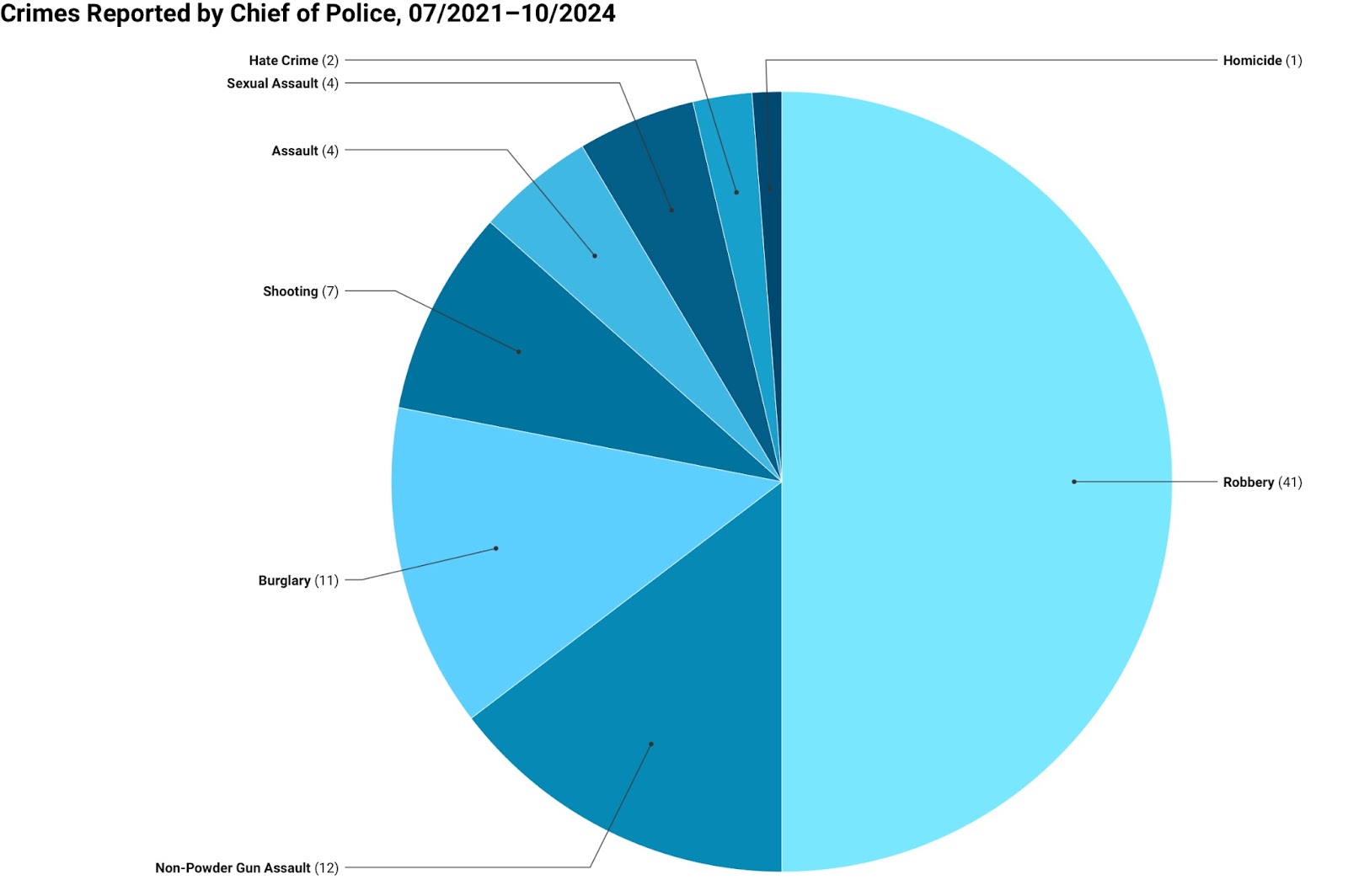DATA: Yale Public Safety warnings, graphed and mapped
Here’s what an analysis of Yale Public Safety emails over the last three years reveals about crime on and near campus.

Aidan Zhou
Yale students regularly receive emails from Chief of Police Anthony Campbell — and previously, his predecessor Ronnell Higgins — with eye-catching subject lines alerting them of safety concerns on and near campus.
Typically labeled as Timely Warnings or Public Safety Advisories, these messages inform of recently reported crimes of immediate relevance to students, faculty and staff. To investigate the nature of such incidents, the News analyzed a sample of 82 Yale Public Safety emails sent between July 2021 and October 2024. Dive into the data to discover what types of crimes are reported by the University, as well as when and where they occur.
Robbery is by far the prevalent subject of Timely Warnings, constituting 50 percent of emails sent in the studied timeframe. This category can be further split into five subtypes: 37 percent were robberies, 34 percent were armed robberies, 24 percent were attempted robberies, 2 percent were bank robberies and 2 percent were carjackings. The choice of distinguishing between these subtypes is made by Yale Police on a case-by-case basis.
Burglaries were not as frequent, with 11 cases making up 13 percent of the dataset.
Non-powder gun assault is another broad categorization that accounted for 15 percent of University-reported crimes. Of the 12 incidents, 50 percent were BB gun assaults, 33 percent were paintball assaults, 8 percent were gel gun assaults and 8 percent were pellet gun assaults.
The remaining 22 percent were made up of shootings, assaults, sexual assaults, hate crimes and one homicide.
This distribution deviates significantly from what was recorded in Yale Public Safety’s annual security report. In particular, Timely Warnings and Public Safety Advisories underrepresent the dangers of sexual violence. Of the 56 cases of rape recorded in 2023, only two were reported as Timely Warnings. A similar departure from the annual report concerns the prevalence of motor vehicle theft; there were 169 cases in 2023 alone.
Most University-reported incidents took place at night, with 33 percent occurring between 10 p.m. and 2 a.m. and 56 percent between 8 p.m. and 4 a.m. Smaller spikes at lunch break — 12 p.m. to 1 p.m. — and the end of classes — 3 p.m. to 4 p.m. — suggest a correlation between student traffic and crime rate.
Across three years of data, the fall semester saw 38 Yale Public Safety emails, a significantly higher number than the 24 emails sent during spring semester. The summer months were not quieter — as one might expect with many students off campus — as June and July accumulated a higher-than-average number of crimes between October 2021 and October 2024. This observation is consistent with the “heat hypothesis,” which posits that crime tends to spike during hotter times of year.
Also of note is the year-to-year increase in Timely Warnings and Public Safety Advisories. Thirty-seven percent of the total emails sent were sent this year — compared to 34 percent in 2023, 18 percent in 2022 and 11 percent in 2021 — despite 2024 not being over yet. As previously reported in the News, there has been an overall uptick in crime since 2021; as such, it is unclear whether this trend is caused by rising crime rates or a change in University communication patterns.

The map above visualizes the data in two ways: one layer filters location markers by type of crime and the other by year. As expected, most are clustered around the Yale campus. However, the geographic scope of Timely Warnings and Public Safety Advisories has visibly expanded since 2021, with more information about crimes in bordering neighborhoods such as Newhallville and The Hill being disseminated to the student body in recent years.
The Clery Act requires universities that receive federal funding to report on crime on and near campus.
Interested in getting more news about New Haven? Join our newsletter!







